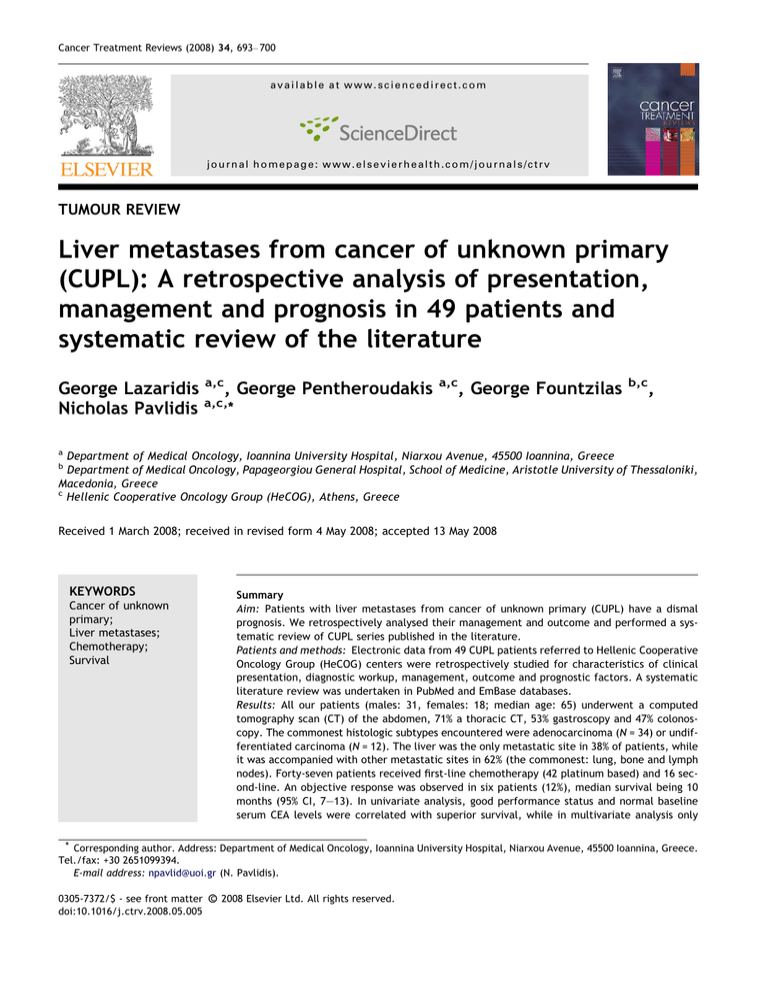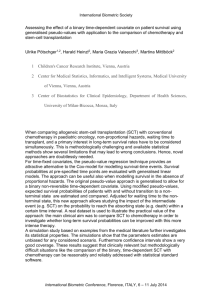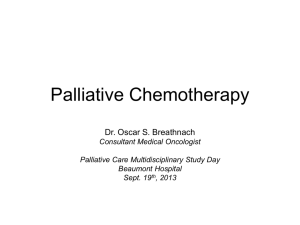
Cancer Treatment Reviews (2008) 34, 693– 700
available at www.sciencedirect.com
journal homepage: www.elsevierhealth.com/journals/ctrv
TUMOUR REVIEW
Liver metastases from cancer of unknown primary
(CUPL): A retrospective analysis of presentation,
management and prognosis in 49 patients and
systematic review of the literature
George Lazaridis a,c, George Pentheroudakis
Nicholas Pavlidis a,c,*
a,c
, George Fountzilas
b,c
,
a
Department of Medical Oncology, Ioannina University Hospital, Niarxou Avenue, 45500 Ioannina, Greece
Department of Medical Oncology, Papageorgiou General Hospital, School of Medicine, Aristotle University of Thessaloniki,
Macedonia, Greece
c
Hellenic Cooperative Oncology Group (HeCOG), Athens, Greece
b
Received 1 March 2008; received in revised form 4 May 2008; accepted 13 May 2008
KEYWORDS
Summary
Aim: Patients with liver metastases from cancer of unknown primary (CUPL) have a dismal
prognosis. We retrospectively analysed their management and outcome and performed a systematic review of CUPL series published in the literature.
Patients and methods: Electronic data from 49 CUPL patients referred to Hellenic Cooperative
Oncology Group (HeCOG) centers were retrospectively studied for characteristics of clinical
presentation, diagnostic workup, management, outcome and prognostic factors. A systematic
literature review was undertaken in PubMed and EmBase databases.
Results: All our patients (males: 31, females: 18; median age: 65) underwent a computed
tomography scan (CT) of the abdomen, 71% a thoracic CT, 53% gastroscopy and 47% colonoscopy. The commonest histologic subtypes encountered were adenocarcinoma (N = 34) or undifferentiated carcinoma (N = 12). The liver was the only metastatic site in 38% of patients, while
it was accompanied with other metastatic sites in 62% (the commonest: lung, bone and lymph
nodes). Forty-seven patients received first-line chemotherapy (42 platinum based) and 16 second-line. An objective response was observed in six patients (12%), median survival being 10
months (95% CI, 7–13). In univariate analysis, good performance status and normal baseline
serum CEA levels were correlated with superior survival, while in multivariate analysis only
Cancer of unknown
primary;
Liver metastases;
Chemotherapy;
Survival
* Corresponding author. Address: Department of Medical Oncology, Ioannina University Hospital, Niarxou Avenue, 45500 Ioannina, Greece.
Tel./fax: +30 2651099394.
E-mail address: npavlid@uoi.gr (N. Pavlidis).
0305-7372/$ - see front matter c 2008 Elsevier Ltd. All rights reserved.
doi:10.1016/j.ctrv.2008.05.005
694
G. Lazaridis et al.
age < 55 (HR 0.16, p = 0.02) and the absence of extrahepatic disease (HR 0.21, p = 0.007) predicted for a better outcome. Published data from four relevant series (total patients = 662) parallel our findings.
Conclusions: Patients with liver metastases from CUP are resistant to conventional types of
treatment and carry a poor prognosis. Understanding the molecular biology of CUP is essential
for the development of new, targeted effective therapies.
c 2008 Elsevier Ltd. All rights reserved.
Introduction
Cancer of unknown primary site (CUP) is defined as histologically confirmed metastases in the absence of identifiable
primary tumor despite a standardized diagnostic approach.1
Clinical and laboratory data required to define a patient as
having CUP are: histologically confirmed metastatic cancer,
histopathology review with use of immunohistochemistry,
detailed medical history, complete physical examination
(including pelvic and rectal examination), full blood count
and biochemistry, urinalysis, stool occult blood testing,
chest radiography, computed tomography of the abdomen
and pelvis, mammography and PET scan (in selected
cases).2,3 Fundamental characteristics of CUP are early dissemination and unpredictable metastatic pattern4,5 coupled
to dormancy or regression of the primary tumor,6–8 and
aggressive biologic behaviour. CUP accounts for 2.3–4.2%
of cancer in both sexes and is marginally more frequent in
males than in females. The median age for occurrence is
60 years.9–14 Therapy is usually ineffective and median survival ranges from 6 to 11 months.15,16 Therefore, the challenge for the treating physician and patient alike is both
diagnostic – how extensive should the exploration for the
primary be – and therapeutic.
Among the most important advances in understanding
CUP biology was the identification of favourable clinicopathologic subsets affecting 10–20% of patients with CUP.
Appropriate diagnosis of such cases is of great importance
as they warrant specific treatment, which is frequently
effective. These are young patients with poorly differentiated carcinoma of midline distribution (extragonadal germ
cell syndrome), women with papillary carcinoma of the peritoneal cavity, women with adenocarcinoma involving only
axillary lymph nodes, patients with squamous cell carcinomas involving cervical lymph nodes, poorly differentiated
neuroendocrine carcinomas, men with blastic bone metastases and elevated PSA (adenocarcinoma), isolated inguinal
adenopathy (squamous carcinoma) and patients with a
single, small, potentially resectable tumor. These patients
respond to antineoplastic therapy and occasionally enjoy
long-term disease control. Unfortunately, more than 80%
of CUP patients do not fall in one of these categories and
belong to the poor-prognosis subset. No chemotherapeutic
regimen has been established as a standard one, despite
variable response rates ranging from 0% to 50% with median
patient survival of 4 to less than 12 months.17
Among poor-prognosis CUP patients, metastases to the liver are frequent, being present in 20–30% of them.7 After
lymph node enlargement, hepatic involvement is the second
leading mode of presentation of unknown primary carcinoma.18 Patients with hepatic metastases from an unknown
primary site have been considered to harbour aggressive,
high-volume and resistant disease with a grim outcome.
Still, anecdotal evidence is the basis for this perception in
most cases and retrospective or prospective data are scant
and infrequently updated. We report presentation, management and outcome data of 49 patients diagnosed with liver
metastases of unknown primary (CUPL) and compare them
with data from other published CUPL patient series identified via a systematic review of the literature.
Patients and methods
From 1999 until 2007 patients with multiple unresectable liver metastases from an unknown primary tumor, with or
without deposits in other organ sites were treated with
cytotoxic chemotherapy either in the context of prospective clinical trials organized by HeCOG or according to offtrial cooperative group protocols in HeCOG participating
centres. These patients had detailed clinical data recorded
in a regularly updated electronic database. Common eligibility criteria for administration of chemotherapy included
histologic or cytologic confirmation of malignancy, adequate bone marrow, hepatic (serum bilirubin <1.5 times
the upper limit of normal ULN, AST and ALT <5 times ULN)
and renal (glomerular filtration rate >40 ml/min by the
Cockroft–Gault formula) reserves, presence of measurable/evaluable disease, absence of significant morbidities
and adequate performance status (ECOG PS 0–3). Tumor response was assessed at all malignant deposits (not solely in
the liver) according to the World Health Organization (WHO)
criteria. The National Cancer Institute Common Toxicity Criteria version 2.0 were used to report toxicity.
The relevant digitalized clinical data were retrospectively collected, reviewed and analyzed in January 2008.
Studied parameters included patient and tumor epidemiologic data, first-line chemotherapeutic management data,
response to treatment, time to progression and overall survival times. Patient characteristics and studied parameters
are shown in detail in Tables 1 and 2. All clinical parameters
were examined for potential prognostic significance for
overall survival by univariate and multivariate analysis.
The objectives of this retrospective study were to depict
the epidemiological profile of patients with irresectable hepatic involvement from CUP, study the chemotherapeutic
regimens used and examine their activity, as well as report
the time to progression after first-line chemotherapy and
overall survival of these patients.
Overall survival (OS) was measured from the date of tissue diagnosis until death from any cause. Surviving patients
were censored at the date of last contact. Time to disease
progression (TTP) was measured from the date of start of
Liver metastases from cancer of unknown primary (CUPL): A retrospective analysis of presentation
Table 1
Table 2
Baseline examinations
Baseline examinations N = 49
Abdominal CT/MRI
Thoracic CT
Pelvic CT
Colonoscopy
Gastroscopy
Bone scintigraphy
Brain CT/MRI
Thyroid ultrasound
ENT
Proctoscopy
Colposcopy
Laparoscopy
Laparotomy
Patients
%
49
35
20
23
26
18
8
1
1
5
4
2
5
100
71.4
40.8
46.9
53.1
36.7
16.3
2
2
10.2
8.2
4
10.2
ENT: ear–nose–throat panendoscopy.
chemotherapy administration until progression or death.
Time to event distributions were estimated using Kaplan–
Meier curves. Univariate analysis of prognostic significance
of various parameters for survival was done with the Logrank test, a p < 0.05 (two-tailed) being considered significant. The Cox proportional hazards regression model was
implemented for multivariate analysis. In order to assess
the strength of association of OS with various variables, a
backward selection procedure with removal criterion
p > 0.10, identified the subclass of significant variables
among the following: gender, age at diagnosis (up to 55 versus 56–65 versus more than 65), performance status (0–1
versus 2–3), histology, grade of differentiation, metastatic
sites (liver only versus liver and one other metastatic organ
site versus liver and two or more other sites), type of
first-line treatment (oxaliplatin-based versus non-oxaliplatin-based), brain metastases (presence versus absence),
markers (all markers normal versus one at least abnormal).
The Wald x2 test and the corresponding p-values < 0.05
were used to determine statistical significance. Logistic
regression analysis was applied in order to examine potential predictive significance of the variables described above
for disease response to first-line chemotherapy.
Results
695
Patient and tumor characteristics/treatment
Patients
Characteristics
Gender
Male/female
%
N = 49
31/18
63/37
Age at diagnosis
Median (range)
65 (36–78)
WHO performance status at diagnosis
0
1
2
3
17
20
11
1
34
40
22,4
2
Histology
Adenocarcinoma
Undifferentiated carcinoma
Neuroendocrine
34
12
3
69
24
6
Number of metastatic sites
Liver only
1
2
3
4
19
13
10
5
2
38
26
20
10
4
Associated metastatic sites
Lung
Lymph nodes
Bone
Peritoneum
Spleen
Adrenals
Brain
13
12
9
4
3
1
1
26.5
24.5
18.4
8.1
6.1
2
2
Treatments
Patients treated by chemotherapy
47
96
Number of patients who received
1 line
2 lines
3 lines
29
16
2
59.2
32.6
4.1
Protocols administered first line
With platinum salt
Oxal/irrinotecan
Carbo/TXT
Without platin salt
42
33
9
4
85.7
67.3
18.4
8.2
Patient and tumor characteristics
From 1999 to 2007, a total of 49 patients fulfilling the criteria of CUPL were registered with the HeCOG electronic
database. Detailed patient, tumor and management data
are shown in Table 2. Median age at diagnosis was 65. There
was a preponderance of men (63.2%). Adenocarcinoma was
the prevalent histologic type accounting for 69% of the
cases, followed by undifferentiated carcinoma (24%).The
most commonly associated metastatic sites were lung, bone
and lymph nodes. Liver was the only metastatic site in 38%
of cases, associated to one organ metastatic site in 26%, two
in 20% and more than two other metastatic sites in 14% of
the cases. Seventeen (34%) patients had a WHO perfor-
mance status of 0 at diagnosis, while 31 patients were
mildly to moderately symptomatic (62%).
Baseline examinations
An abdominal computed tomography scan (CT) was carried
out in all patients (Table 1). A thoracic CT took place in
35 (71.4%) patients while 20 patients (40.8%) underwent a
pelvic CT. Colono- and gastroscopy was carried out in
46.9% and 53.1% of the patients retrospective, driven by
suspicious signs, symptoms or laboratory tests. Bone scintigraphy was done in 18 (36.7%) of the cases, while a brain CT/
696
magnetic resonance (MRI) in 8 (16.3%). Other baseline
examinations that took place were thyroid ultrasound
(2%), ear–nose–throat panendoscopy (ENT) (2%), proctoscopy (10%), colposcopy (8%), laparoscopy (4%) and laparotomy in 10.2%. CA 19-9, CA125, CA 15-3 and CEA were the
most common markers utilized. All markers were normal
in nine patients (18%), while 35 patients (70%) had at least
one serum marker level abnormal at baseline. Serum marker
levels were determined at baseline in order to identify surrogate markers of response that are more easily followedup, rather than to suggest the primary tumor.
Treatment efficacy and toxicity
Of the 49 patients of this series, 47 (96%) were managed
with first-line chemotherapy, while two did not because of
rapid deterioration due to progression of malignancy (Table
2). The high rate of management with chemotherapy is
interpreted by the fact that only patients fit enough for such
therapy were recorded in the HeCOG protocol registry. Only
two patients (4.1%) were operated for liver metastases and
four (8.2%) treated with ionising radiotherapy. Twenty-nine
patients did not receive salvage regimens after failure of
first-line chemotherapy, 16 received a second-line chemotherapeutic regimen and only two a third-line. Protocols received as first-line chemotherapy either contained a
platinum salt (considering as such the oxaliplatin as well):
carboplatin/docetaxel, oxaliplatin/irinotecan and oxaliplatin/capecitabine, or did not: 5-fluorouracil (5FU)/leucovorin, docetaxel, capecitabine and 5FU/irrinotecan.
An oxaliplatin-based chemotherapy was administered in
34 (68%) patients. No response (defined as stable disease
(SD) or progressive disease (PD)) was seen in 74% of the patients. An objective response (complete remission (CR) or
partial remission (PR)) was observed in six patients (12%).
If stabilization of disease can be considered of clinical
significance, control of the disease (CR + PR + SD) was
achieved in 14 patients (30%) (Table 5). Responses and disease stabilization were short-lived, as the majority of patients progressed either while on therapy or soon after its
completion (56%). Patient outcome was exceptionally poor,
as median TTP was 4 months and median overall survival 10
months. Only 35% of patients survived longer than one year
from diagnosis, while 2-year survival was less than 10% (two
patients). The most common hematologic toxicities were
neutropenia and anemia (with one patient suffering grade
IV febrile neutropenia), while the most frequent non-hematologic ones were constitutional and gastrointestinal.
Prognostic/predictive factors for outcome
Several clinical, histopathological and management parameters (age, gender, performance status, histology, grade,
baseline serum tumor markers, number of metastatic organ
sites, brain metastases and administered chemotherapy)
were tested for potential utility as prognostic factors for
overall survival as well as for predictive utility for response
to chemotherapy (Table 3).
In univariate analysis, good performance status and normal CEA levels were significantly associated with a reduced
hazard for death. Patients with PS 0–1 had a median OS of
12 months (95% CI 8–16 months) versus a median OS of 3
G. Lazaridis et al.
months (95% CI 1–6 months) for those with PS 2–3 (Logrank
p = 0.003). Patients with normal baseline serum CEA had a
median OS of 12 months (95% CI 5–18 months) versus 7
months (95% CI 3–11 months) for those with elevated serum
CEA (Logrank p = 0.03). The absence of extrahepatic
dissemination showed a trend for statistically significant
association with superior survival. In the more robust multivariate analysis, young age <55 years and metastatic
involvement of the liver only with absence of other organ
deposits significantly predicted better outcome. Age <55
was associated with a hazard ratio (HR) for death of 0.16
(95% confidence intervals CI 0.04–0.8, p = 0.02) and disease
confinement to the liver with a HR for death of 0.21 (95% CI
0.07–0.7, p = 0.007). At logistic regression, no clinical, laboratory or pathologic variable predicted for response to
chemotherapy at a significance level <0.05.
Review of the literature
We performed a manual search of the Pubmed online database using the search engine: (cancer OR carcinom* OR neoplas* OR malignan* OR tumor OR tumor) AND (‘‘unknown
primary’’ OR ‘‘unknown origin’’ OR ‘‘occult primary’’)
AND (liver OR hepatic). Our search was limited to the English and French language. We encountered four patient
series of CUPL, presented below in chronological order
(Table 4).
In 1991, Mousseau et al.7 presented a series of 91 patients with liver metastases from CUP. The liver was the
only site of disease in 31% of patients. Adenocarcinomatous
histology of good to moderate differentiation was seen in
78% of patients. The median overall survival did not differ
between patients with liver only and patients with extrahepatic deposits and was disappointingly low (4–5 months).
No clinicopathologic variable was found to carry prognostic
significance for patient outcome, though patients receiving
chemotherapy (80% of total) fared better than those who
did not. However, this was likely to result from a selection
bias as fitter patients who usually survive longer were the
ones most likely to receive chemotherapy. Objective response rate was 11% with a variety of combination cytotoxic
regimens incorporating 5-fluorouracil, cyclophosphamide,
vinca alkaloids and anthracyclines. Responders had a median survival of 9 months, in sharp contrast to the median
survival of 3.5 months seen in non-responders (p = 0.001).
Upon disease progression, salvage chemotherapy was
largely ineffective.
In 1998, Ayoub et al.18 presented the biggest series ever
published, encompassing 365 patients with liver metastases
from an unknown primary tumor. The objectives of the
study were to identify clinicopathologic variables with prognostic significance for patient outcome, determine the common primary tumors identified, assess the yield of specific
diagnostic tests and evaluate the impact of therapy on survival. Out of 1522 patients with suspected CUP, 500 had
metastases primarily to the liver and a primary tumor was
identified in 135 (27%). From the 365 remaining patients
with CUPL, 38% had metastases to liver only and 62% to liver
and additional organ sites. The predominant histologic subtype was adenocarcinoma (61%). As in the general population of CUP patients, lymph nodes, bone and lung were
Liver metastases from cancer of unknown primary (CUPL): A retrospective analysis of presentation
the most common additional sites of involvement. CUPL patients had a significantly higher death rate than other CUP
patients, with a HR after adjusting for other prognostic factors of 1.75 (95% CI, 1.52–2.03; p < 0.0001). Median survival
was only 7.2 months. Pathology, age and number of metastatic sites were found to be independent prognostic factors
for survival. Histologic features consistent with neuroendocrine carcinoma were associated with a significantly lower
death rate than patients without these, with a HR of 0.29
(95% CI, 0.18–0.47; p < 0.0001). A regression model with
these three prognostic factors resulted in an adjusted HR
for a 20-year increase in age of 1.3 (95% CI, 1.0–1.5;
p = 0.022), for a four-unit increase in number of metastatic
sites of 1.5 (95% CI, 1.0–2.1; p = 0.04), and for neuroendocrine histology of 0.3 (95% CI, 0.19–0.49; p < 0.0001). Chemotherapy was given more frequently in patients younger
than 60 years compared with those older than 60 (75% versus
46%). Patients who received chemotherapy were mostly fitter and younger than the ones who did not and thus had a
significantly lower death rate, with a HR of 0.52 (95% CI,
0.41–0.66; p < 0.0001). The effect of chemotherapy being
more pronounced in patients with adenocarcinoma histology
(HR 0.43; 95% CI, 0.32–0.58; p < 0.0001).
In 2002, Hogan et al.19 retrospectively analysed 88 patients with a suspected CUP and liver biopsy-proven hepatic
metastases over a 10-year period (time period not specified). There was a preponderance of males (58 out of a total
of 88 patients), with a median age at diagnosis of 64.5. Adenocarcinoma was the prevalent histologic subtype accounting for as much as of 80% of all cases. Patients with
adenocarcinoma for whom adequate survival data were
available (N = 62) were further analysed for factors that
may influence outcome. In 8/62 (11%) patients a primary tumor was identified. There was no separate statistical analysis for the two distinct subgroups: those for whom no
primary tumor was identified (CUPL) and those for whom a
primary was eventually identified. 16/62 patients received
active treatment with either surgery, radiotherapy, singleagent chemotherapy or a combination protocol, the rest
being managed with palliative care only. The median survival for treated patients (49 days) versus untreated patients (52 days) was not significantly different (p = 0.128).
Patients <65-years-old were more likely to receive active
treatment (p = 0.006). Age (HR 1.01, p = 0.178), active
treatment (HR = 0.65; p = 0.194), identification of the primary tumor (HR = 0.60, p = 0.213) and male gender
(HR = 0.88; p = 0.642) had no significant effect on survival.
In 2005, Pouessel et al.20 conducted a retrospective
study of 118 CUPL patients, over a 10-year period of time
from 1993 to 2002. The most frequent histologic type was
again adenocarcinoma (57.6%). Hepatic metastases were
isolated in 32 patients, other metastatic sites being the
lymph nodes, lung and bone. Patients (107) received at least
front-line chemotherapy, 74 platinum-based. In first-line
chemotherapy, overall response rates were 19.4% with
administration of platinum combinations and 20% with
non-platinum regimens. The median overall survival was
6.6 months, the type of chemotherapy (with or without
platinum) bearing no impact on survival (p = 0.35). The
median survival for treated patients was 7 months. In univariate analysis five variables had a statistically significant
negative effect on survival: performance status > 1, liver
697
metastasis producing the presenting manifestations, elevated serum CA 19-9 concentrations, abnormal serum alkaline phosphatase and elevated LDH. Inversely, presence of a
neuroendocrine CUP and administration of chemotherapy
were linked with a better prognosis. At multivariate analysis, independent factors associated with poor prognosis
were elevated serum LDH and altered performance status
with reported odds ratio for death of 2.4.
Discussion
CUPL is an unfavourable subset of cancer of unknown primary site which, as it is clear from the literature review
we performed, is not well studied. Only five clinical series
have been published with small numbers of patients (total
number 711), while no controlled or prospective trials on
this CUP subset exist. Opposite to what is true in most other
CUP subsets in which only a slight male gender preponderance is seen, in CUPL males outnumber females by a ratio
of almost 2:1. Median age at diagnosis is 61–65. There is
agreement between all the published series that lung, pancreatic and colorectal primary tumors are most commonly
identified in the setting of CUP patients presenting with liver metastases. In this point, it is important to comment
on the extension of the clinical and laboratory tests that
must take place in order to identify a primary tumor. The
search for the primary must be done by meticulous history
and physical examination, a CT scan of the chest, abdomen
and pelvis supplemented by detailed histopathological studies (immunohistochemistry, electron microscopy and advanced molecular technology). Mammography, endoscopy
(ENT panendoscopy, bronchoscopy, colonoscopy, proctoscopy and colposcopy) and other scans should only be undertaken in the presence of suspicious signs, symptoms or
laboratory abnormalities or in the presence of compatible
clinical presentation (isolated axillary adenopathy for mammography). Remarkably, not all the series in our review
comment on the extensiveness of the diagnostic work-up.
One has to bear in mind that the identification of the primary tumor is important only if a favourable clinicopathologic subset is suspected, in which case a more labored
search can be justified (electron microscopy, molecular
techniques and PET scan).
CUP cases (70–80%) belong to poor risk subsets, for
which a more labored search for the primary tumor is not
reasonable since it carries no information of prognostic or
therapeutic relevance. Recently, large retrospective series
have suggested that patients presenting with CUP carry different biology and natural history from tumors with known
primary sites: Bishop et al.21 found inferior outcome of patients with metastatic adenocarcinoma of unknown primary
in comparison to patients with metastatic deposits from
known primary tumors of the lung, breast and gastrointestinal tract. Moreover, the drug regimens used for the
management of patients with known gastrointestinal (5-fluorouracil, mitomycin, irinotecan, oxaliplatin, etc.) or lung
(platinum, taxanes, gemcitabine, vinorelbine, etc.) metastatic tumors seem ineffective in the equivalent unfavourable subsets of CUP patients. The lack of therapeutic
impact of primary site identification in poor-risk CUP patients may change when new effective primary site-specific
698
Table 3
G. Lazaridis et al.
Prognostic factors for patient survival
Univariate
Multivariate
OS
95% CI
Age groups
Up to 55
55–65
>65
15
10
7
9–21
3–17
5–10
0.08
PS groups
0–1
2–3
12
3
8.3–15.6
1–6
0.003
Metastatic sites
Unique
Multiple
13
7
9.5–16.4
4–10
0.09
CEA
Normal
Abnormal
12
7
5–18
3–11
0.03
therapies (cetuximab, bavacizumab, tyrosine kinase inhibitors, etc.) become available and establish their utility.
The most commonly involved metastatic sites in addition to hepatic involvement are similar in all series: lymph
nodes, bone and lung. Adenocarcinoma is the prevalent
histology (64%), followed by undifferentiated carcinoma
(20%), neurondocrine (8.4%) and squamous (3%). Among
the most significant contributions of our systematic review
is the identification of prognostic factors that predict for
patient outcome and may ultimately allow for tailored
treatment according to risk of death. In Ayoub’s study patients with features consistent with neuroendocrine carcinoma had a three- to fivefold better survival than those
with other histologies. The longer survival of these patients
may result from an inherently different disease biology.
Thus, CUP patients with neuroendocrine carcinoma that involves the liver seem to harbour a tumor with biology that
resembles the one of known primary counterparts (e.g.,
pancreatic islet cell tumors): they are relatively slow-growing tumors and are often associated with prolonged survival
frequently measured in years. Neuroendocrine differentiation, when present, seems to portend a good prognosis
for other primary tumors as well (breast, colon, lung cancer, etc.). Age, number of metastatic sites, LDH and performance status have all been found to be independent
prognostic factors in uni- and multivariate analysis for survival in the series that we are examining. Young age and
deposits in the liver only were found to be significantly
associated with better outcome on multivariate analysis
in our series. Interpretation of the complex mechanisms
by which these variables influence clinical outcome is speculative, as they may reflect cancer biology, disease bulk,
host biology, tissue perfusion, drug metabolism, clearance
and drug access to tumor cells. High-volume disease may
be difficult to contain or it may simply be a marker of
aggressive malignant biology. Presence of metastases in
multiple sites may affect pivotal organs for host biochemical functions, alter drug metabolism or seed sites inaccessible to cytotoxic chemotherapy (sanctuary sites).
p
HR
95%CI
p
0.16
1.02
0.04–0.8
0.35–2.9
1
0.02
0.9
0.21
1
0.07–0.7
0.007
Performance status may have an impact on drug metabolism, drug impact on tumor cells, immune surveillance
and tolerability of cytotoxic chemotherapy. Moreover, it
may reflect disease virulence, host reserves and
inflammation.
What is noteworthy is that several investigators claim
that chemotherapy offers survival benefit in CUPL patients,
in spite of overall response rates around 20% and absence of
prospective patient randomisation. In Ayoub’s series chemotherapy-treated patients had a lower death rate than
those who were not treated with chemotherapy (hazards ratio (HR),0.52; p < 0.0001). In Mousseau’s series, when patients were able to receive chemotherapy, median survival
was better (4 months) than without (median survival 1
month; p = 0.005). In addition, in the case of objective response to chemotherapy, the median survival was 9 months
versus 3.5 months for patients without objective response
(p = 0.001). In Poussel’s series median survival was 6.6
months for both treated and untreated patients and for
the treated only patients median survival was 7 months. In
Hogan’s series, there was not a difference in median survival between those who were or not treated with chemotherapy. In our series (Lazaridis et al.), there is no such
comparison because 47/49 patients were treated with chemotherapy (patients in HeCOG’s protocols). It should be
stressed that the limitations of these studies make the conclusion that chemotherapy is of benefit, unsafe. The retrospective nature of the series potentially allow for several
biases. Patients who received chemotherapy may have been
of better performance status compared with the ones who
did not or may have harboured less aggressive tumors. The
superior survival of patients responding to chemotherapy
may be due to toxic effects in non-responders or to a detrimental impact of chemotherapy on survival in nonresponders.
Median survival times in the series under study range
from 1.7 to 10 months. This difference probably reflects
the inherent heterogeneity of cancer of unknown primary.
In Hogan’s series only 26% of the patients received chemo-
Liver metastases from cancer of unknown primary (CUPL): A retrospective analysis of presentation
Table 4
Clinicopathologic characteristics of all published CUPL series
Histology
Adenocarcinoma
(%)
Undifferentiated
(%)
Neuroendocrine
(%)
Squamous (%)
Others (%)
Most common
primary tumors
Associated
metastatic sites
Lung (%)
Bone (%)
Lymph nodes (%)
Peritoneal (%)
Adrenal (%)
Brain (%)
Median survival
(months)
Mousseau et al.
(N = 91)
Ayoub et al.
(N = 365)
Hogan et al.
(N = 88)
Pouessel et al.
(N = 118)
Lazaridis et al.
(N = 49)
Total
(N = 711)
78
61
79.5
58
69
65
12
26.5
3.5
20
24
20
9
9
14
6
8.4
6
4
NR
2
1
Lung (18%),
colorectal (17%),
pancreas (16%)
4.5
3.5
Colorectal
(37.5%), lung (25%)
4
3.5
NR
0
NA
NR
3
NR
NR
NR
NR
NR
36
37
46
13
12
4
7.2
NR
NR
NR
NR
NR
NR
NR
NR
NR
NR
1.7
6.6
26.5
18.4
24.5
8.1
2
2
10
NR
64.5
61
65
Histology
(neuroendocrine,
age, number of
metastatic sites)
None
LDH, PS
NR
NR
66
33
58
42
Median age at
diagnosis
Prognostic factors
4 months (liveronly metastases)–5
months (the
others)
61(males) 59
(females)
None
Gender
Male (%)
Female (%)
58
42
Table 5
699
63
37
Responses to chemotherapy
Pouessel et al.
Mousseau et al.
Lazaridis et al.
First line
Second line
First line
First line
Second line
Without platinum
CR (%)
PR (%)
SD (%)
N = 40
0
20
10
N = 36
0
2.8
8.3
N = 65
N=4
0
0
0
N=8
0
0
12.5
With platinum (including oxaliplatin)
CR (%)
PR (%)
SD (%)
N = 67
1.5
17.9
11.9
N = 10
0
10
10
N = 43
4.7
9.3
18.6
N = 18
0
10
20
therapy, while in ours 47/49 patients were treated with
chemotherapy. Other contributing factors may be different
selection criteria, since our series only includes patients fit
enough to tolerate cytotoxic chemotherapy. No chemotherapy regimen has been found convincingly effective for the
majority of CUP patients presenting with disseminated liver
Second line
11
3
NR
NR
NR
NR
NR
NR
or multi-organ metastases. Despite some evidence of response, median survival is still in the range of 8–9 months.
Our analysis of CUPL patients confirms the overall poor
prognosis generally attributed to this patient population.
Nevertheless, within this unfavourable population of CUPL,
small subsets of patients with a more favourable prognosis
700
can be identified (e.g. those harbouring neuroendocrine
tumors). Breakthroughs in understanding of the molecular
biology and pathophysiology of CUP are imperatively
needed, in order to identify key molecular aberrations that
could be targeted by smart drugs. Moreover, patient selection by means of molecular profiling would be pivotal so as
to administer effective, individualised therapy that would
inhibit molecular events that drive each specific patient‘s
tumor.22 Chemotherapy is likely to continue playing a role
for chemical cytoreduction of the malignant clone. However, this is likely to prove effective only if combined with
targeted agents that would reverse resistance and would
suppress repopulation of metastatic deposits.
Conflict of interest statement
None declared.
References
1. Pavlidis N, Fizazi K. Cancer of unknown primary (CUP). Crit Rev
Oncol Hematol 2005;54(3):243–50.
2. Abbruzzese JL, Abbruzzese MC, Lenzi R, Hess KR, Raber MN.
Analysis of a diagnostic strategy for patients with suspected
tumors of unknown origin. J Clin Oncol 1995;13(8):2094–103.
3. Frost P, Raber MN, Abbruzzese JL. Unknown primary tumors as
unique clinical and biologic entity: a hypothesis. Cancer Bull
1998;41:139–41.
4. Le CT, Cvitkovic E, Caille P, Harvey J, Contesso G, Spielmann M,
et al. Early metastatic cancer of unknown primary origin at
presentation. A clinical study of 302 consecutive autopsied
patients. Arch Intern Med 1988;148(9):2035–9.
5. Nystrom JS, Weiner JM, Heffelfinger-Juttner J, Irwin LE,
Bateman JR, Wolf RM. Metastatic and histologic presentations
in unknown primary cancer. Semin Oncol 1977;4(1):53–8.
6. Kolesnikov-Gauthier H, Levy E, Merlet P, Kirova J, Syrota A,
Carpentier P, et al. FDG PET in patients with cancer of an
unknown primary. Nucl Med Commun 2005;26(12):1059–66.
7. Mousseau M, Schaerer R, Lutz JM, Menegoz F, Faure H, Swiercz
P. Hepatic metastasis of unknown primary site. Bull Cancer
1991;78(8):725–36.
G. Lazaridis et al.
8. Pentheroudakis G, Briasoulis E, Pavlidis N. Cancer of unknown
primary site:missing primary or missing biology? Oncologist
2007;12:418–25.
9. Coates M, Armstrong B. Cancer in New south Wales. Incidence
and mortality. NSW: Cancer Council; 1995.
10. Komov DV, Komarov IG, Podrguliskii KR. Cancer metastases
from an unestablished primary tumor (clinical aspects, diagnosis, treatment). Sov Med Rev F Oncol 1991;4:1–33.
11. Levi F, Te VC, Erler G, Randimbison L, La Vechia C. Epidemiology of unknown primary tumors. Eur J Cancer
2002;38:1810–2.
12. Muir C. Cancer of unknown primary site. Cancer 1995;75:
353–6.
13. Parkin DM, Muir CS. Cancer incidence in five continents.
Comparability and quality of data. IARC Sci Publ(120):45–173.
14. Visser O, Coebergh JW, Schouten LJ. Incidence of cancer in the
Netherlands. Utrecht: The Netherlands Cancer Registry; 1993.
15. Abbruzzese JL, Abbruzzese MC, Hess KR, Raber MN, Lenzi R,
Frost P. Unknown primary carcinoma: natural history and
prognostic factors in 657 consecutive patients. J Clin Oncol
1994;12(6):1272–80.
16. van der GA, Verweij J, Planting AS, Hop WC, Stoter G. Simple
prognostic model to predict survival in patients with undifferentiated carcinoma of unknown primary site. J Clin Oncol
1995;13(7):1720–5.
17. Sporn JR, Greenberg BR. Empirical chemotherapy for adenocarcinoma of unknown primary tumor site. Semin Oncol
1993;20(3):261–7.
18. Ayoub JP, Hess KR, Abbruzzese MC, Lenzi R, Raber MN,
Abbruzzese JL. Unknown primary tumors metastatic to liver.
J Clin Oncol 1998;16(6):2105–12.
19. Hogan BA, Thornton FJ, Brannigan M, Browne TJ, Pender S,
O’Kelly P, et al. Hepatic metastases from an unknown primary
neoplasm (UPN): survival, prognostic indicators and value of
extensive investigations. Clin Radiol 2002;57(12):1073–7.
20. Pouessel D, Thezenas S, Culine S, Becht C, Senesse P, Ychou M.
Hepatic metastases from carcinomas of unknown primary site.
Gastroenterol Clin Biol 2005;29(12):1224–32.
21. Bishop JF, Tracey E, Glass P, Jelfs P, Roder D. Prognosis of subtypes of cancer of unknown primary (CUP) compared to
metastatic cancer. J Clin Oncol 2007;25(18 Suppl.):21010.
22. Pentheroudakis G, Pavlidis N. Perspectives for targeted therapies in cancer of unknown primary. Cancer Treat Rev
2006;32:637–44.






